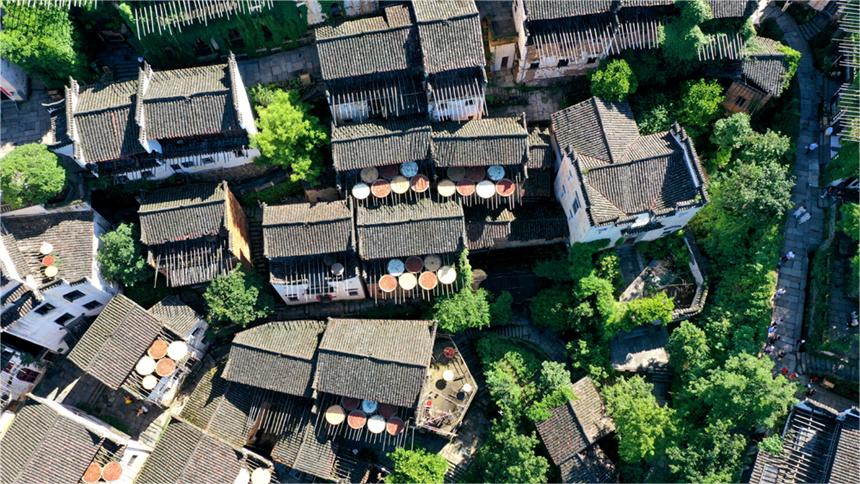Innovation fortifies China's "green Great Wall" against desertification
HOHHOT, June 5 (Xinhua) -- About 400 km north of the Chinese capital Beijing, hundreds of workers are racing against time to build neat rows of square-shaped sand barriers in an endless stretch of desertified land, in which they plant tree seedlings.
This place is on the southern edge of the Horqin sandy land, the largest of its kind in China and a key battlefield of the country's ambitious Three-North Shelterbelt Forest Program (TSFP) aimed at mitigating desertification.
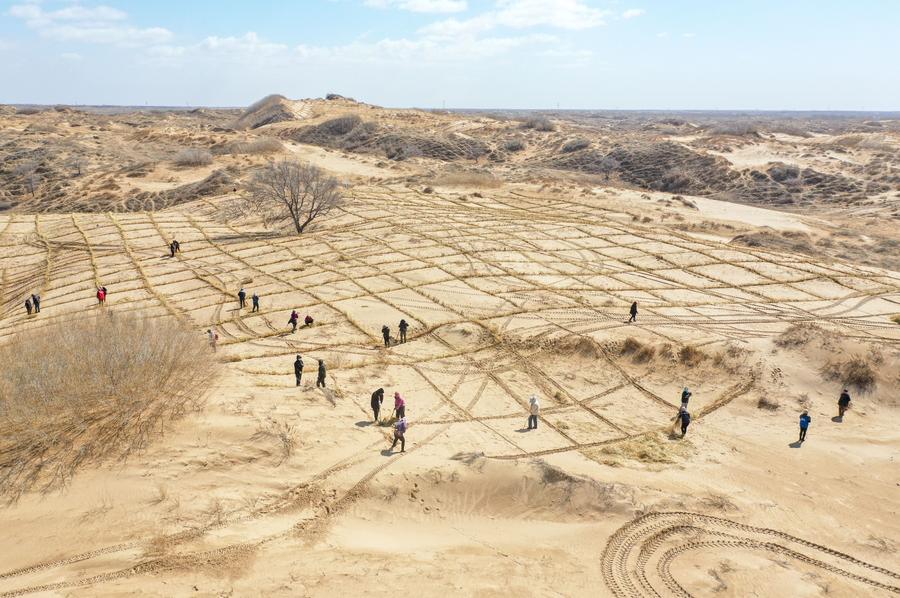
An aerial drone photo taken on March 28, 2024 shows workers building square-shaped sand barriers with straw in the Horqin sandy land in Tongliao City, north China's Inner Mongolia Autonomous Region. (Xinhua/Lian Zhen)
Wednesday is World Environment Day, designated by the United Nations to encourage awareness and action for protecting the environment. China proposed in June 2023 to turn the TSFP into a fully functional and unbreakable "green Great Wall" and ecological security barrier in northern China.
Home to four of China's major deserts and four major sandy areas, Inner Mongolia Autonomous Region, on the country's northern border, has long been plagued by desertification and land erosion. With the progress of the TSFP, the region has vigorously intensified its afforestation efforts.
"Each worker can lay up to 4 mu (about 0.27 hectares) of dried straw grids per day," said Zhang Xudong, director of the forestry and grassland bureau of Aohan Banner (county), the city of Chifeng, where afforestation under the TSFP is in full swing every spring and summer.
The county authorities have mobilized more than 500 workers to plant tree seedlings in an area of 4,000 mu over the past month, he said, adding that in another seven or eight years, this sandy area, the closest sandstorm source to Beijing, would be transformed into forest and grass.
Through strenuous efforts, China has expanded its afforestation area by 32 million hectares under the TSFP since the program was first launched in 1978.
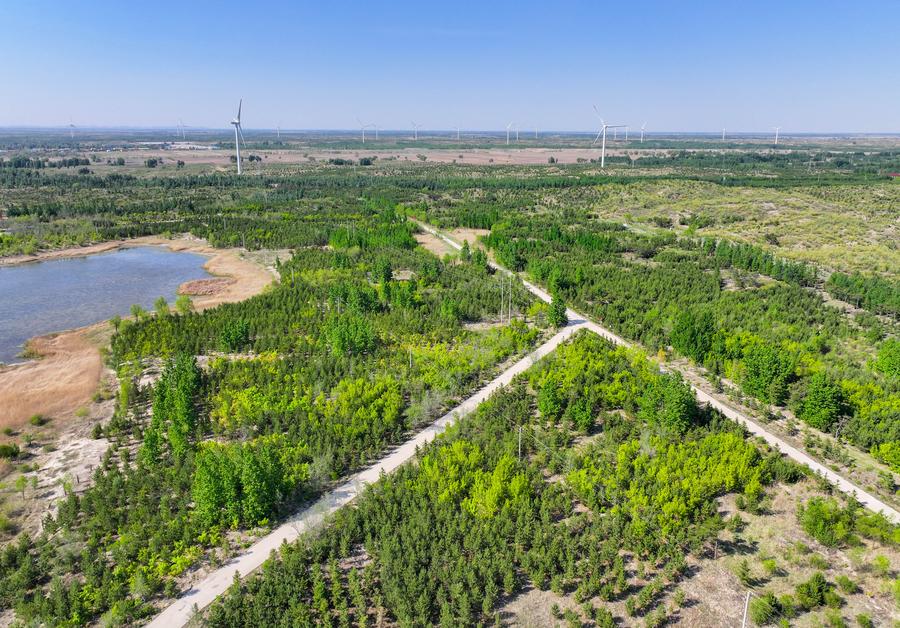
An aerial drone photo taken on May 15, 2024 shows tree seedlings planted at an afforestation area in the Horqin sandy land in Tongliao City, north China's Inner Mongolia Autonomous Region. (Xinhua/Lian Zhen)
Scheduled to be fully completed in 2050, the TSFP aims to rehabilitate and green desert-prone lands and desertified areas in northwest, north and northeast China. By 2050, the afforestation area under the TSFP is projected to encompass over 4 million square kilometers across 13 provincial-level regions in China, accounting for 42.4 percent of the country's total land area.
Provincial-level authorities are making comprehensive efforts. Inner Mongolia has proposed a comprehensive treatment plan for 17.3 million mu of sandy land this year. Hebei Province in northern China has set a target of afforesting 6 million mu while restoring 500,000 mu of degraded grasslands. Meanwhile, Gansu Province in northwest China aims to complete afforestation and grass planting on 9.45 million mu of sandy land this year.
SUSTAINABLE SAND CONTROL
In late May, Wang Feng, a researcher at the Chinese Academy of Forestry, visited Horqin Left Wing Rear Banner, situated in Tongliao City in the eastern part of Inner Mongolia, to assist in reviewing the latest afforestation efforts.
On the edge of the Horqin Sandy Land, Wang Feng noticed rows of newly planted pine seedlings standing amid bushes. "Although the wind has been strong in recent days, there is little sand blowing on my face. Despite the exposure of the newly afforested area to sand, it has been strategically populated with grass, shrubs and trees to effectively prevent sand movement," he said.
According to Wang, local afforestation efforts have gained increasing expertise, employing scientific plant distribution methods to pursue sustainable ecological improvement.
Pine tree seedlings are planted in deep pits protected by sand barriers made with straw and covered with a shallow layer of soil. Through this method, the survival rate of the tree seedlings has increased from about 50 percent during the initiation of the Horqin desertification control under TSFP in 2013 to 90 percent today.
The Horqin Sandy Land is primarily situated in the cities of Tongliao and Chifeng. Along the western edge of the sandy land, Chifeng has implemented a strategy to combat desertification by expanding greenery along roads.
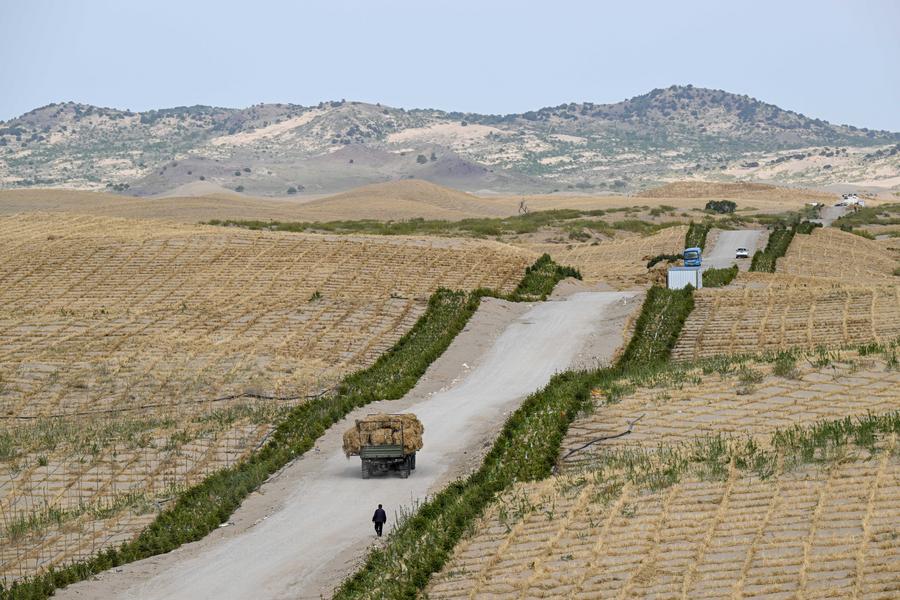
This photo taken on May 16, 2024 shows a road winding through the sandy land in Ongniud Banner in Chifeng City, north China's Inner Mongolia Autonomous Region. (Xinhua/Lian Zhen)
In Chifeng's Ongniud Banner, over 400 kilometers of roads have been constructed in the sandy land, accompanied by an expansion of the green shelterbelt along these roads to cover 5.78 million mu.
Dubbed an "ecotourism circle," the road network has become a popular travel route for self-driving tours. Last year, the Ongniud Banner saw 1.6 million tourists and achieved a total tourism revenue of 1.76 billion yuan (about 242.8 million U.S. dollars).
AGRIVOLTAICS INDUSTRY
Along with the progress of TSFP, Inner Mongolia is not just seen as a shield for the country's ecological security, but a hotbed for new energy development.
Major Chinese energy companies are keen on investing in the development of agrivoltaics in Inner Mongolia. Agrivoltaics combines new energy power generation with agricultural production, offering benefits to both industries and farmers while contributing to expanding greeneries in ecologically fragile sandy areas.
In Inner Mongolia today, large wind and photovoltaic power facilities dot the landscape. Amid a vast expanse of solar panels, sheep roam and graze on fresh grass, while farmers cultivate drought-resistant plants and medicinal herbs for profits.
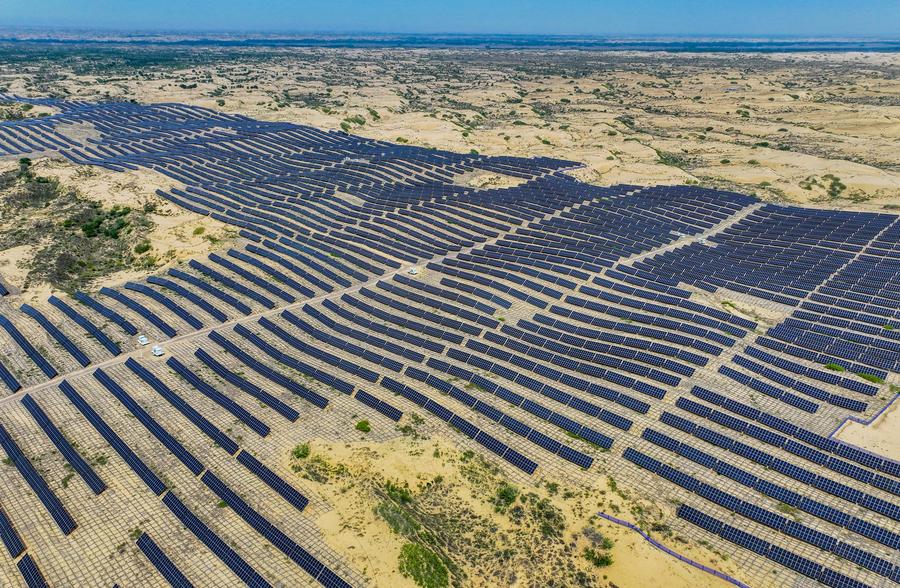
An aerial drone photo taken on May 16, 2024 shows a photovoltaic power facility in a sandy land in Aohan Banner in Chifeng City, north China's Inner Mongolia Autonomous Region. (Xinhua/Lian Zhen)
China's leading nuclear power operator, China General Nuclear Power Corporation, achieved a significant milestone in December 2023 with the full-capacity production and grid connection of its wind power facility in Inner Mongolia, capable of generating more than 10 billion kWh of electricity annually. Located in Hinggan League, Inner Mongolia, this project stands as the country's largest operational onshore wind power base.
China Three Gorges Corporation has forged cooperation with Inner Mongolia Energy Group for the construction of a mega solar and wind power base in China's seventh-largest desert, the Kubuqi. The project is designed with an overall installed capacity of 16 GW, equivalent to that of Baihetan, China's second-largest hydropower station.
In the heart of the Kubuqi Desert, over 100 bulldozers are tirelessly leveling undulating sand dunes to reclaim desert land for the construction of a new photovoltaic base.
The construction site of the Shuofang new energy base is expected to cover a total area of 487,000 mu in the desert. With a total investment of approximately 11.5 billion yuan, the new facility is planned to have an installed annual capacity of 13 GW.
According to Li Jinyu, the person in charge of the construction, the project is scheduled to achieve a 1-GW power generation capacity with electricity connected to the grid by the end of this year.
Liu Xiaorong, director of the forestry and grassland bureau of Hangjin Banner, said with the construction of the Shuofang new energy base, local authorities plan to promote agricultural development by cultivating suitable cash crops, utilizing the space beneath the panels.
Photos
Related Stories
- China sets up fund to support Three-North Shelterbelt Forest Program
- China reports marked progress on ecological restoration at UN event
- China to launch 5th nationwide ecological condition survey
- China rolls out national standards for ecological restoration of mines
- Ecological monitoring index of China's Sanjiangyuan National Park receives approval
Copyright © 2024 People's Daily Online. All Rights Reserved.






